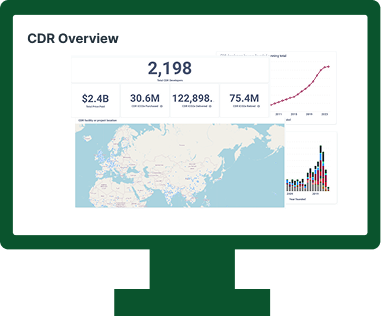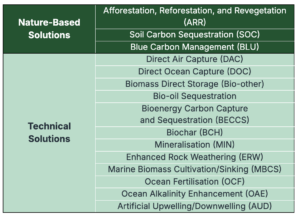
Voluntary Carbon Market Insights & FAQs
Everything you’ve ever wanted to know about the voluntary carbon market – and more!
Carbon Dioxide Removal (CDR)
What is Carbon Dioxide Removal (CDR)?
Carbon Dioxide Removal (CDR) refers to activities that extract CO2 from the atmosphere and store it securely in geological formations, terrestrial ecosystems, ocean reservoirs, or products. As defined by the IPCC, CDR involves “removing CO2 from the atmosphere and storing it durably.” Simply put, it’s a way to reduce atmospheric CO2 levels permanently.
Why is CDR Important?
To meet the global climate goals outlined in the Paris Agreement and limit warming to well below 2°C, reducing greenhouse gas emissions isn’t enough. Carbon Dioxide Removal is critical for:
-
Neutralizing residual emissions from hard-to-abate sectors.
-
Reversing historical emissions to restore atmospheric CO2 levels to safer thresholds.
-
Achieving net-negative emissions to cool the planet over time.
How Does CDR Differ from Carbon Capture and Storage (CCS)?
While CDR and CCS both involve CO2 capture, their approaches differ:
-
CCS: Captures emissions at the source (e.g., power plants) before they enter the atmosphere.
-
CDR: Targets CO2 already present in the atmosphere for permanent removal and storage.
Types of Carbon Dioxide Removal Methods
CDR methods fall into two categories: Nature-Based Solutions and Technical Solutions.
Nature-Based Solutions
These methods rely on natural ecosystems to absorb and store CO2. Examples include:
-
Afforestation, Reforestation, and Revegetation (ARR)
-
Soil Carbon Sequestration (SOC)
-
Blue Carbon Management (BLU)
What CDR Data Does AlliedOffsets Track?
At AlliedOffsets, we track the global Carbon Dioxide Removal landscape to enhance market transparency and provide actionable insights.
1. Global Project Monitoring
-
Track CDR projects worldwide (nature-based and technical).
-
Regularly update project data as facilities progress through various stages.
2. Project Lifecycle Stages
Monitor project phases:
-
Announced
-
Construction
-
Pilot
-
Demonstration
-
Operational
This helps assess technology readiness and maturity.
3. Registry & Off-Registry Transactions
-
Track transactions from major registries like Verra, Puro, and Gold Standard.
-
Include off-registry voluntary and emerging compliance markets.
4. Credit Purchases & Deal Types
-
Monitor credit transactions via MOUs, offtake agreements, and spot purchases.
-
Collect data on volume, price, and delivery timelines.
5. CDR Buyers
-
Profile buyers by sector (e.g., tech, finance, consumer goods) and geography.
-
Identify trends among first-time and repeat buyers.
6. Investment Flows
-
Analyze funding by investor type (VC, PE, corporate, grants).
-
Track method-specific investments and funding rounds.
-
Monitor new market entrants.
7. Geospatial Data
-
Use project coordinates to analyze regional trends, biodiversity metrics, and policy contexts.
8. Pricing Data
-
Aggregate prices from registries, marketplaces, RFPs, and buyers.
-
Track price bands and future projections by method.
9. Facility Capacity
-
Record and analyze CO2 removal capacity per project (tonnes/year).
-
Monitor growth trends across sectors and regions.
10. Additional Insights
-
Policies influencing CDR.
-
Patents and academic research related to CDR.
Our Market Trends Dashboard offers a real-time view of these insights, providing unparalleled visibility into the global CDR landscape.

